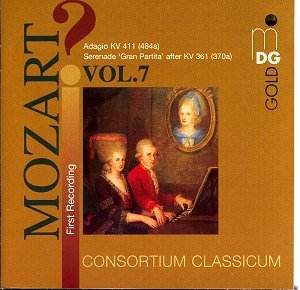The Collegium Classicum is a formidable ensemble. Their
playing is always stylish and they react to each other in true chamber-music
fashion, yet each player seems to supply solos with character aplenty.
Couple this with an exemplary recording, and surely you have a winner?
Well, that rather depends on the actual music they
are playing. The Adagio in B flat, K484a, is scored for two clarinets
and three basset horns and was probably composed towards the end of
1785, possibly for the Freemasons. It is a most beautiful piece which
is given a highly sensitive performance here. As will be seen, it may
well be the only reason to spend good money on this disc.
Franz Gleissner (1759-1818), a minor composer who is
better remembered for his involvement with early lithography in music
publishing, arranged Mozart’s Gran Partita for twelve wind instruments
(including basset horns) and double bass as a ‘Sinfonie concertante’
for a more manageable mixed ensemble which includes two violins, viola
and cello. In doing so, he softened the edges which make Mozart's original
so compelling (outdoor music as undisputed masterpiece). The resultant
over-civilised sound certainly takes some getting used to, and the loss
of the ‘raw’ wind effect means that one’s attention span can decrease
with alarming rapidity.
The arrangement is, admittedly, expertly and deftly
done, and there are many imaginative touches, but it does rather demean
Mozart’s achievement rather than enhance it. The great third movement
Adagio is hopelessly cushioned, with woodwind soloists singing over
strings which sway in the breeze. It is true that the following Menuetto
is robustly done, but the replacement of horns by strings robs the characteristic
‘horn-call’ intervals of their effect. Perhaps the biggest shock is
the opening of the Finale, now on string quartet, so that it does indeed
sound like the last movement of a string quartet rather than the original’s
robust gallop.
This is not quite the nineteenth century equivalent
of putting a disco beat behind Mozart 40, but it's not far off. The
Consortium Classicum bring all the life and care for detail one would
expect, but even they cannot rescue this arrangement.
One of the most civilised, harmless discs I have ever
come across. Play it while you cook the dinner.

![]() Collegium Classicum
Collegium Classicum ![]() Dabringhaus und Grimm
Gold MDG301 1077-2 [60.01]
Dabringhaus und Grimm
Gold MDG301 1077-2 [60.01]